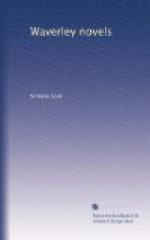The solitude and repose of the whole scene seemed almost monastic; and Waverley, who had given his horse to his servant on entering the first gate, walked slowly down the avenue, enjoying the grateful and cooling shade, and so much pleased with the placid ideas of rest and seclusion excited by this confined and quiet scene, that he forgot the misery and dirt of the hamlet he had left behind him. The opening into the paved court-yard corresponded with the rest of the scene. The house, which seemed to consist of two or three high, narrow, and steep-roofed buildings, projecting from each other at right angles, formed one side of the inclosure. It had been built at a period when castles were no longer necessary, and when the Scottish architects had not yet acquired the art of designing a domestic residence. The windows were numberless, but very small; the roof had some nondescript kind of projections, called bartizans, and displayed at each frequent angle a small turret, rather resembling a pepper-box than a Gothic watchtower. Neither did the front indicate absolute security from danger. There were loop-holes for musketry, and iron stanchions on the lower windows, probably to repel any roving band of gypsies, or resist a predatory visit from the caterans of the neighbouring Highlands. Stables and other offices occupied another side of the square. The former were low vaults, with narrow slits instead of windows, resembling, as Edward’s groom observed, ’rather a prison for murderers, and larceners, and such like as are tried at ’sizes, than a place for any Christian cattle.’ Above these dungeon-looking stables were granaries, called girnels, and other offices, to which there was access by outside stairs of heavy masonry. Two battlemented walls, one of which faced the avenue, and the other divided the court from the garden, completed the inclosure.
Nor was the court without its ornaments. In one corner was a tun-bellied pigeon-house, of great size and rotundity, resembling in figure and proportion the curious edifice called Arthur’s Oven, which would have turned the brains of all the antiquaries in England, had not the worthy proprietor pulled it down for the sake of mending a neighbouring dam-dyke. This dove-cot, or columbarium, as the owner called it, was no small resource to a Scottish laird of that period, whose scanty rents were eked out by the contributions levied upon the farms by these light foragers, and the conscriptions exacted from the latter for the benefit of the table.
Another corner of the court displayed a fountain, where a huge bear, carved in stone, predominated over a large stone-basin, into which he disgorged the water. This work of art was the wonder of the country ten miles round. It must not be forgotten, that all sorts of bears, small and large, demi or in full proportion, were carved over the windows, upon the ends of the gables, terminated the spouts, and supported the turrets, with the ancient family motto, ‘Beware the Bear’,




